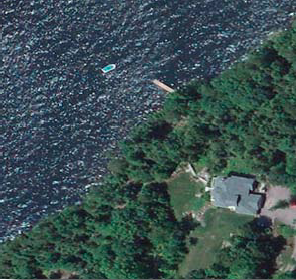The Lake Champlain Basin Program (LCBP) has released a study examining the effects of lakeshore development on Lake Champlain's shoreline habitat. The study conducted by Fitzgerald Environmental Associates began in 2011 and examined 90 shoreline locations along Malletts Bay in Colchester, VT with the goal of quantifying and understanding the effects of lakeshore development on shallow, near-shore habitat in Lake Champlain. The study is timely given that Vermont is considering adopting shoreline regulations to protect shoreline habitat.
Using high-resolution aerial photography to create detailed maps of shoreline conditions and lakeshore land use, the contractors examined the relationships between these conditions and the biological communities near shore, primarily macroinvertebrates which help to form the base of the food web. The contractor found that as shoreline development increases, riparian vegetation decreases, resulting in decreased shading, habitat cover, and inputs of woody debris and organic matter to the littoral zone. The decrease reduces material available for macroinvertebrates and changes the dynamics of beach erosion, particularly in sandy sites. The study results were generally consistent with findings from studies of smaller inland lake studies in Vermont.
The study’s shoreline protection recommendations included:
- Identifying 10 shoreline priority areas for conservation across the Malletts Bay study area in Colchester, VT where data indicates a high terrestrial or littoral habitat value;
- Guiding Lake Champlain shoreline property owners on the alternatives to traditional “hard bank” stabilization techniques.
An increasing body of literature from the U.S. and across the globe has linked shoreline development with reduced habitat quality in the littoral zones of lakes and ponds. Littoral habitat is defined as the shallow shoreline area of a lake. In the Lake Champlain Basin and throughout the region, there is rising concern over the degradation of lake littoral zones resulting from shoreline development. While other states in the New England have adopted shoreline protection regulations, there are no statewide rules or regulations in Vermont or New York restricting the nature or proximity of shoreline development above the mean high water. In response to ongoing littoral zone degradation in the absence of statewide regulations, the Vermont Department of Environmental Conservation (VTDEC) has made substantial efforts to research this topic. Various VTDEC studies on inland lakes in Vermont and Maine highlight the sensitivity of the littoral zone to adjacent development, and the importance of buffer regulations in mitigating impacts.
Prior to this study, limited research had examined the impacts of lakeshore development on littoral habitats of Lake Champlain. Given the larger scale of physical and hydrologic process in Lake Champlain relative to smaller inland lakes, a key question spurring this research was whether the littoral zone response in Lake Champlain would differ from the inland lakes. The littoral zone of Lake Champlain is strongly influenced by seasonal changes in lake hydrology, large tributary inputs of sediment and organic matter, diverse shoreline geology and geomorphic forms, and severe differences in wind and wave exposure dependent on shoreline aspect. The LCBP study was designed to utilize a relatively small set of representative sample points on the lake’s shoreline to understand conditions in the greater lake. Malletts Bay was chosen as the principal study area due to its wide ranging natural characteristics and varying shoreline land cover.
